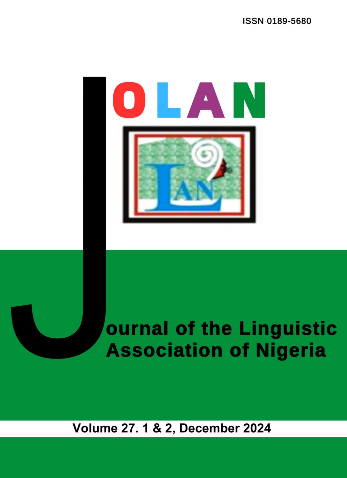Affixation in Hausa and Kambari Languages
Keywords:
Hausa, Kambari, Affixation, Derivational MorphologyAbstract
This article investigates the operation affixes in the Hausa and Kambari languages. Affixes are means of changing the base or root of a word to adjust its meaning and fit into different syntactic and semantic contexts. In this article, I analyse the functions of affixes in these languages (Hausa and Kambari) with a view to bringing out their rich and interesting affixal elements basically from the account of derivational morphology which is concerned with forming new lexemes, i.e. words that differ either in syntactic or semantic category from their bases, to be extremely productive in the languages under discussion. The qualitative research method was employed in data collection and analysis. Essentially, the focus has to do with the determination of universal properties of human languages and parametric variations cross-linguistically.
References
Abubakar, A. (2001). An Introduction to Hausa morphology. Faculty of Art monograph, University of Maiduguri.
Adrian, A., Richard, D., Ann, K. & Robert, M.H. (2003). Introduction to Language. Cambridge: MIT Press.
Alhassan, B. (2011). Transfixation in Hausa: A hypothetical analysis. Studies in the Department of African Languages and Cultures. Ahmadu Bello University, Zaria.
Bature, A. (1991). The thematic argument and semantics roles in Hausa: Morphosyntax and lexical Semantics Interface. Ph.D. thesis, Stanford University.
Bloomfield, L. (1933). Course ḏe linguitique generale. Language New York: Holt Rinehart and Winston.
Chomsky, N. (1957). Syntactic structures. The Hague: Mouton.
Chomsky, N. (1965). Aspect of the theory of syntax. Cambridge: Mass. MIT Press.
Fromkin, V., Rodman, R. and Hyams, N. (2011). An Introduction to Language. Wadsworth: Cengage Learning.
Galadanci, M. (1976). Introduction to Hausa grammar. Ibadan: Longman.
Haspelmath, M. (2002). Understanding morphology. London: Hodder Education.
Jinju, M. (1980). Rayayyun Nahawun Hausa. Zaria: Northern Nigerian Publishing Company.
Katamba, F. (1992, 1989). An introduction to phonology. New York: Longman.
Katamba, F. (1994). Morphology. London: Macmillan Press.
Litosseliti, L. (2013). Research methods in linguistics. London: Bloomsbury.
Mamman, M. (2012). Essay on Hausa grammar and linguistics. Zaria: Ahmadu Bello University Press.
Mathews, P. H. (1997). An introduction to the theory of word structure. Great Britain: Cambridge University Press.
Ndimele, O. (1999). Morphology and syntax. Port Harcourt: Emhai Press.
Newman, P. (1973). Grades, vowel tone classes and extensions in the Hausa verbal ‘system’. Journal of African Language and Linguistics, 6(4), 59-73.
Newman, P. (2000). The Hausa language: Encyclopedic reference grammar. New Haen: Yale University Press
Parsons, F. (1960). The verbal system in Hausa: Forms, functions and grades. Africa and Ubersee, 44(1), 1- 36.
Yule, G. (1996). The Study of Language. Cambridge: Cambridge University Press.














